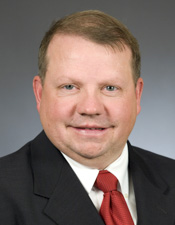Bill aims to build more broadband where Internet service is lacking
Rural communities with slow Internet access — or none at all — would get another chance at state funding for broadband, under a bill sponsored by Rep. Ron Kresha (R-Little Falls).
Under HF593, the state’s Border-to-Border Broadband Fund would get $50 million for a second one-year round of grants targeted at unserved and underserved areas.
In its first year, the fund drew applications totaling $44 million and awarded $19.4 million, Kresha told the House Greater Minnesota Economic and Workforce Development Policy Committee Thursday.
The committee voted to refer the bill to the House Job Growth and Energy Affordability Policy and Finance Committee. It has no Senate companion.
Expansion of broadband service is as important in the 21st century as rural electrification was in the 20th, said Lake County Information Systems Director Angie Dickison.
Long Prairie Mayor Don Rasmussen said schoolchildren in his community had to travel at night to find Wi-Fi service in order to do homework. And, he added, lack of high-speed Internet had cost the city’s industrial park an opportunity to lease to an interested business.
“It’s gone,” he said.
Rep. Mike Sundin (DFL-Esko) called the fund “a terrific economic development tool.” Getting Internet service to unserved areas, he said, will “relieve a lot of heartburn.”
More money, more speed?
Rep. Kim Norton (DFL-Rochester) had two amendments to Kresha’s bill but opted not to move the first, which would have increased funding to $100 million over two years, after Kresha objected. He cited “political reality” and Gov. Mark Dayton’s proposed funding level of $30 million.
“We’re above that [amount]. The minority leader called me out on the House floor for spending $50 million,” Kresha said. “The realities of getting this done are more important than the political fight.”
Norton’s second amendment would have changed the definition of “unserved areas.” She said the bill’s standard for what constitutes broadband service — 4 megabits per second for downloads and 1 megabit per second for uploads — is “dated and inadequate.” She proposed substituting the Federal Communication Commission’s current definition of broadband service: 25 megabits per second for downloads and 3 megabits per second for uploads.
But Rep. Brian Johnson (R-Cambridge) said that would expand the area of the state defined as underserved, increasing grant competition for areas that completely lack Internet access. Rep. Steve Green (R-Fosston) agreed, saying awards might go to less-deserving communities that are able to hire better grant writers. The committee rejected the amendment on a voice vote.
Wireless alternative
It was the panel’s second time this session grappling with the issue of bringing broadband to Greater Minnesota. The committee heard an overview on broadband last week from the Department of Employment and Economic Development’s Office of Broadband Development and the Governor’s Task Force on Broadband.
At that meeting, Rep. Pat Garofalo (R-Farmington), who was not at Thursday’s hearing, objected to the state choosing broadband over what he said is the more promising technology of wireless Internet service.
Related Articles
Search Session Daily
Advanced Search OptionsPriority Dailies
Ways and Means Committee OKs proposed $512 million supplemental budget on party-line vote
By Mike Cook Meeting more needs or fiscal irresponsibility is one way to sum up the differences among the two parties on a supplemental spending package a year after a $72 billion state budg...
Meeting more needs or fiscal irresponsibility is one way to sum up the differences among the two parties on a supplemental spending package a year after a $72 billion state budg...
Minnesota’s projected budget surplus balloons to $3.7 billion, but fiscal pressure still looms
By Rob Hubbard Just as Minnesota has experienced a warmer winter than usual, so has the state’s budget outlook warmed over the past few months.
On Thursday, Minnesota Management and Budget...
Just as Minnesota has experienced a warmer winter than usual, so has the state’s budget outlook warmed over the past few months.
On Thursday, Minnesota Management and Budget...

